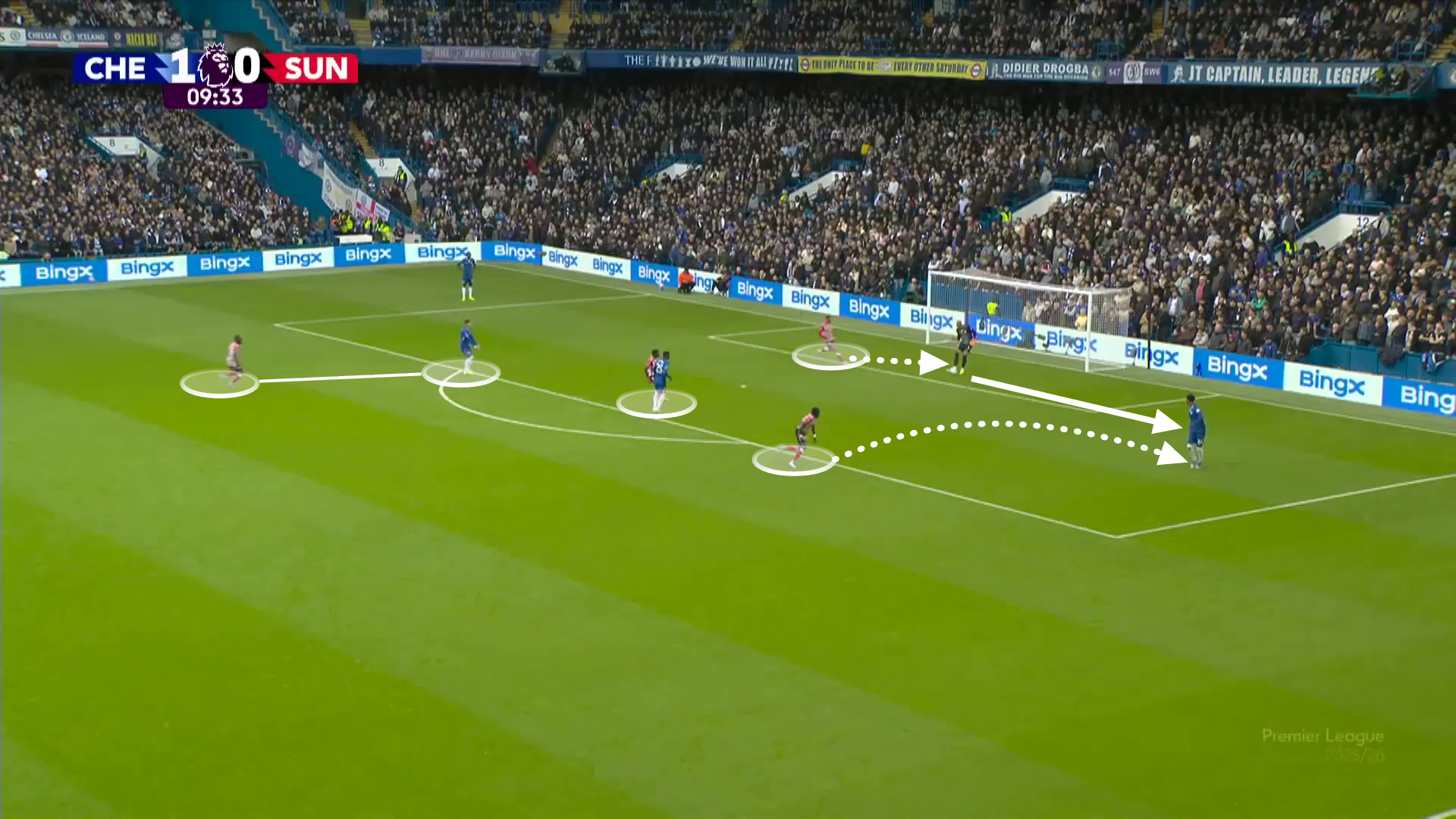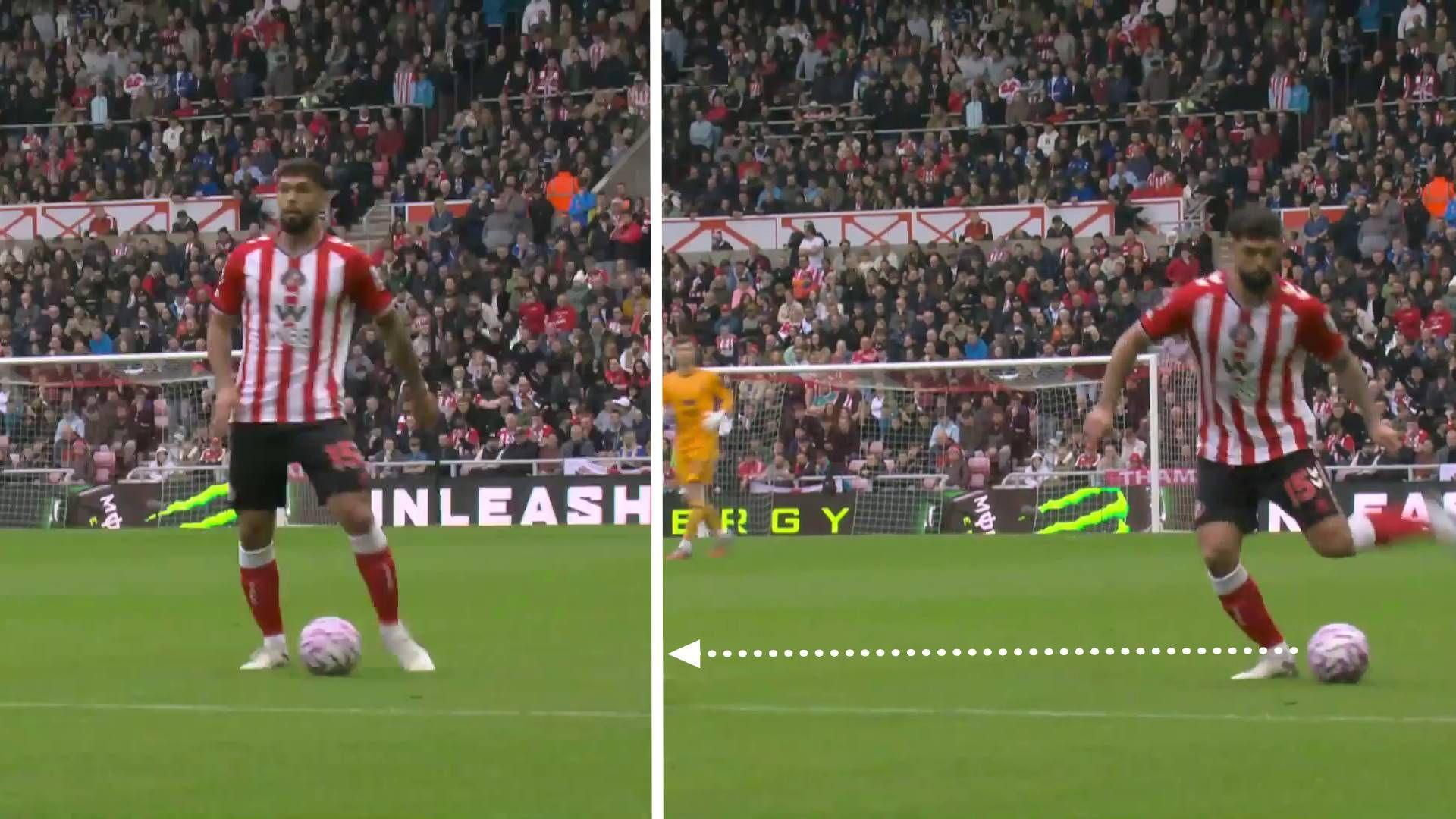The tactics behind Sunderland's impressive start
- Published
If Sunderland beat Everton on Monday they will move from seventh to second in the Premier League - five points behind leaders Arsenal.
With 10 games gone, more attention is paid to the standings and it's fair to say that at the start of the season few pundits would have had the Black Cats hovering around the Champions League places.
So, how have the unassuming Regis le Bris and his overhauled Sunderland side managed to be the surprise package so far this season?
Here we analyse their tactics both in and out of possession - and the ways they have found success using them.
Out of possession
Le Bris' tactical variety is evident in Sunderland's out-of-possession play this season. Though they have been difficult to break down defensively, that hasn't only been by defending deep.
Sunderland tend to begin aggressively. Le Bris instructs his players to press high, often in a man-to-man fashion, and their ability to execute this has been impressive.
Newly promoted teams are reluctant to defend in this way because getting it wrong leaves you more exposed, with individuals needing to cover larger distances alone. With the speed of the Premier League, Sunderland's decision to adopt this approach following promotion is brave but has paid off for them.
In their 2-1 win at Chelsea on 25 October, their man-to-man high press forced their hosts back. The press often aimed to force Chelsea towards their left given they lacked a left-footer in central defence. This reduced the success of the Blues' build-up play from the back.
Sunderland apply this high press when opponents take their goal-kicks but have shown a willingness to jump as a team and press in a man-to-man fashion, often using back passes as the trigger for the team to press together.

Sunderland's aggressive man-to-man press posed Chelsea some problems in the first half
This pressure is occasionally bypassed. When Sunderland are pushed deeper, they then take a mostly zonal approach to defending, commonly blocking space in a 4-4-2 shape. Against Chelsea, and later against Manchester United, they blocked space using a back five - reinforcing their ability to adapt.
Their deeper defensive shape is incredibly strong, too, and being able to have the same 11 players do both approaches in the same game to a high level poses lots of problems for opponents.
In their deeper defensive shape, Le Bris' men aren't solely zonal defenders and do apply pressure to individual opponents near them, reducing the time they have on the ball.
If the ball is eventually played into the box, the central defenders have proven themselves as strong individual duellers. Robin Roefs has prevented more goals than any other goalkeeper in the league this season too. According to xG, most keepers would have conceded three more goals than he has, given the shots he has faced.

Sunderland settled into a 5-4-1 defensive block in the second half before scoring the winner late on via a counter attack
In possession
In possession, Le Bris mostly opts for a positional style of play, meaning he wants his team to occupy certain zones on the pitch. Different players can rotate to occupy these spaces but generally the same spaces have a player within them.
From the goalkeeper, Sunderland often build up from the back, using the quality of their defenders and midfielders to help them get up the pitch. They typically do this by spreading their back four wide with the keeper standing between both central defenders before Granit Xhaka and Noah Sadiki dart deep showing for the ball from central midfield positions.
They aren't, however, afraid to go long and often look for Wilson Isidor in a route one fashion, particularly against an impressive opposition press or from winning positions.

Here we can see Sunderland's preferred build-up structure. Roefs however sensibly goes long given Chelsea's good pressure
Once Sunderland have established possession, they then look to break teams down. The central midfielders mentioned can drop into the defensive line to get on the ball with more time and space, which is a smart use of their skillset.
With more time on the ball, Xhaka is able to dictate play from deep, often playing inch-perfect switches of play to the wingers, getting them in one-on-one situations.
It is worth mentioning centre-back Omar Alderete, who played for Getafe last season. During that campaign he was the most 'incisive' passer when compared with all central defenders with more than 15 games played. He ranked first for the percentage of recoveries he turned into progressive passes.
His front-footed nature in possession has certainly helped Sunderland get up the pitch this season and individually, his ability to be deceptive in pretending to pass it towards one side before fizzing it forward at a different angle has made him one of the club's standout players.

Alderete faces up suggesting he will play the pass down the line before playing it in-field at the last second fooling the nearby pressing opponent
In the final third, most of their play is centred around getting into good crossing positions in the wide areas. The full-backs are vital to this either through overlapping the winger, putting in crosses themselves, or underlapping and acting as support for the winger.
Xhaka again smartly moves towards the flank with both the full-back and winger and is usually positioned well to cross it in first-time following a lay-off.
These triangles ensure Sunderland have a dangerous threat out wide and rotations between these players make their threat less predictable.
Trai Hume's versatility out wide on both flanks, or inverting, has enabled much of this attacking threat. Against Chelsea he started in a wide defensive position off the ball in Sunderland's back five but in possession, Sunderland moved into a 4-3-3 with Hume playing as one of the attacking midfielders.

The inverted position of both full-backs here are on show as Mukiele plays a one-two with Hume before scoring
From winning positions, we know that Sunderland press less and block space deeper. When this happens they look to play long. They're able to sit in the defensive shape for large parts of games because they have individuals who are able to carry the ball up the pitch, relieving pressure on the defence. They can also progress the ball through long passing up to the strikers.
And as Premier League football has trended this season, Sunderland have made sure to make set-piece threat an important part of their game with goals coming from well-worked routines from corners, free-kicks and the use of long throws.
Conclusions
For the sake of this article, out-of-possession and in-possession phases of play are separate sections but Le Bris has said he wants to "link the phases" of his system – having his players see the system as a whole rather than individual parts.
When Sunderland have the ball, they are conscious of how they will defend and have players behind the ball ready to cover if they are to lose the ball. When they play direct, the team looks to move up together reducing spaces between defence, midfield and attack, again to ensure they are better prepared defensively.
What is clear in this analysis is that Sunderland are both balanced and well-drilled. They have solutions to numerous problems and move between these set-ups fairly seamlessly, whether that be defending with a back four or five, whether that means pressing high or defending deep, and whether that means playing slowly and with possession or attacking directly.
Their position in the table accurately reflects the quality they've shown so far this season.

